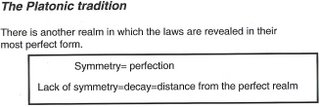Polchinski Elected Member Of National Academy of SciencesPolchinski's discovery of D-branes and their properties is, according to the Academy citation, "one of the most important insights in 30 years of work on string theory."
Can I tell a little story before I head into the essence of this posted thread below?
From one mechanic to anotherI am not a mechanic by trade. Yet I had taken apart, and put back together motors which ran and ran well. Through a transition period, and without a place in which to do this work myself, I decided to give it to "a mechanic" to work on. Pay the price, which was well beyond my means at that time. With three children a wife, and barely making it, I asked for help financially. It was cold, and snow blowing.
After picking up my motor and installing it. Making sure everything was right, I went for a slow drive to seat my rings in newly honed out cylinders. Well, much to my dismay and lots of dollars, blue smoke clouded the world behind me.
Taking it back home, I called the mechanic, and told him what was happening. "It was something you must of done," he siad.
So, I called another mechanic. He compression tested the cylinders for me, and to my dismay and his, one of the cylinders was not up to par.
So what things did I learn?
That I could have "one mechanic go against another," for the shoddy work that was done? No, it doesn't work that way.
After tearing off the head, I had found they had broken the oil and compression rings, as they pushed the compressed rings and piston, back into the cylinder. They had cracked them while doing this. The cracked ring gouged the cylinder wall, as it went up and down on the crankshaft.
Were there things I might have done different now? Maybe pressure tested the cylinders before hand?
Anyway, on to the subject of this post.
After doing my research and investigations into how the standard model itself might have been displayed, I selected two events, that were very discriptive of what might have happened, when taken as a whole story of the science in progress.

These were censored by Peter Woit on his site and removed. These lead to questions that might have implicated "string theory" as part of the process of inquiry beyond the standard? See
Icecube.
If one holds to the idea that they had assumed a counter position to currents trends, then would it not include the theoretical approach well understood, that it also attached, not just a geometrical association, but one described in the physics process as well?
As a layman, this was proving itself, as I looked at the diversity of the geometrical models choosen to represent that abstract world. See
B Field and Hitchins.
Genus Figures, and
topology, on this site.
More and more, it had weighted heavily on my mind, that the consistancy through which selected comments were shown, were to hold validation processes as to anti-string theory. As tones of select comments, as very disconcerting to me, but through his awareness Peter did strived to referee.
The overall message, was not one with the care which Cosmic Variance had ascertained it's caution of String evangelistism, or Lubos Motl's declaration as well, that the underlying motivation, was more to provide a "general widesweping statement" that applied to the string model development as a whole.
IMpressional MindsIf as a student, having now moved toward my senior years, how could I have turned back the clock of time, that I might have stood beside any of these leaders of science?
That I had to accustom myself to the very level on which my opinion would not have mattered coming from layman status. So being on the bottom of the totem pole, I accept the resolve to which such treatment was dealt. It was a small price to pay.
So imagine then, what the overall message by Peter has done to those prospective entries into the world of, might now have said, why should we now enter, being the brunt of what good science men hate, would have us believe?
The Reductionistic ProcessIs it incorrect to say that the events of the collision process are incapable of decribing all fawcetts of the standard model?

So by concentrating on the collision process itself, what factors would have said that no, the standard model does not fit the current processes in LHC? Does not fit the process in high energy collision process to earths atmospheric conditions, for evdience of? See Pierre Auger expeirments here. See John Bachall and the Ghost particle.

So by closely looking at the poor man's version, what process would lead one to believe that the standard model was inclusive in this interactive process as well?
Here's the post in full. It was in response to
Jack Safartti's comments and the document in which he had wrote was in contradiction of what I had learnt of the "
possible new physics?" THis is of course held within context of collider results and the micro perspective results, created the form of quark Gluon Plasma. A superfluid?
So both events involved, "microstate blackhole" recognitions.
Post removed from Peter Woits comment sectionIn regards to facing nightmares
In recent years the main focus of fear has been the giant machines used by particle physicists. Could the violent collisions inside such a machine create something nasty? "Every time a new machine has been built at CERN," says physicist Alvaro de Rujula, "the question has been posed and faced."
The link was added here now.
If one follows the logic development, Jack's position becomes a interesting one to question. As well, such thoughts about cosmic collisions, and the high energy particles cosmological events. Microstate blackhole processes are the poor man's experimental pallete. Just as valid the dissipative state created in the collider.
The resulting end product is what is being explore with ICECUBE. It is all consistent with the standard model. Right from, the start of the collision process, to the resulting shower created.
Jack has some explaining to do?
Update (To help anonymous understand better I hope the student does not feel s/he has to learn string theory in order to be valid in existance. Also, the interactive shower from the collison process with high energy article is well understood and what comes from it.
He deletes yours too.! Oh look, what we have in common?:) What drivel have you drummmed up?)
Anyway. As I was saying.
This is not to slight Peter Woit in the slighest, but to move him to consider the enormity with which the process of string/M theory is involved in the standard model expression. As fundamental particles and the interactions thereof.
To reject the model on the basis of preference, is of course for any who choose to follow which road. But to say that such a process should not be followed would have been a erroneous statement, as well as influencing the general population by such ascertions of preference aghast and in reaction.
Of course I recognized it is his blog and his comment section. On the basis of his dislike for anyone, can do anything they like, within reason right?
See:
History of the Universe and the Standard model















